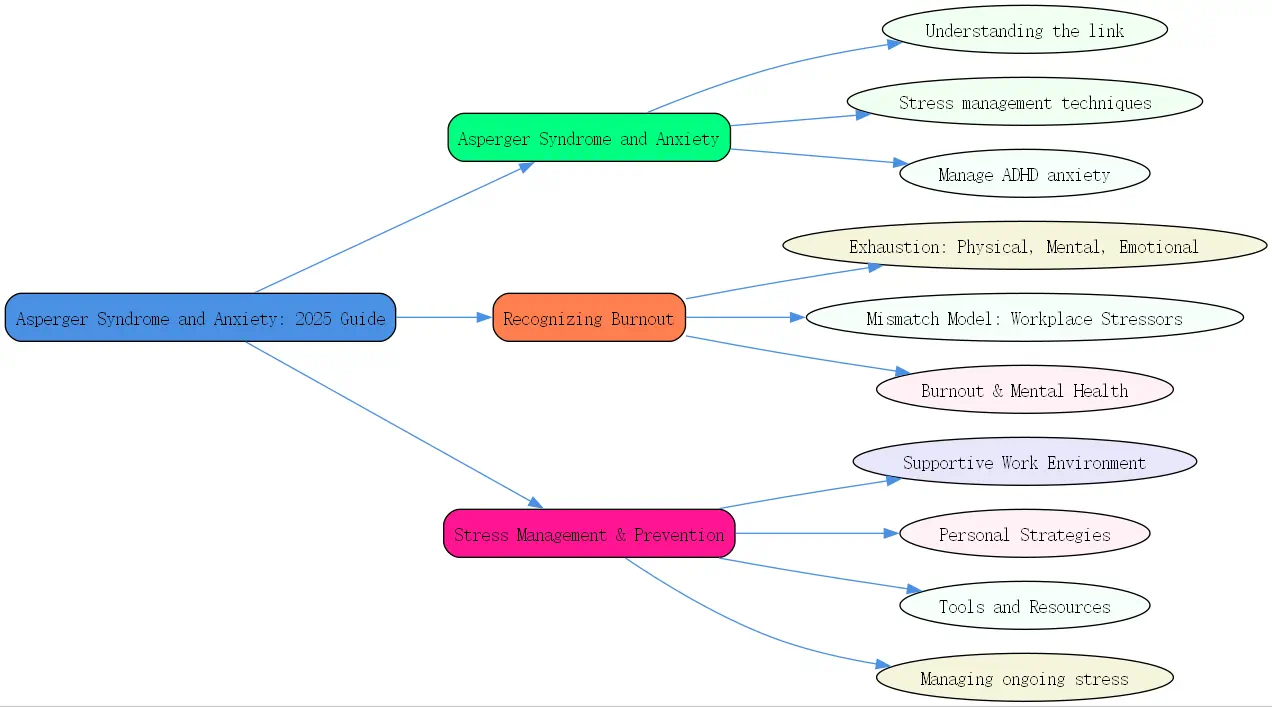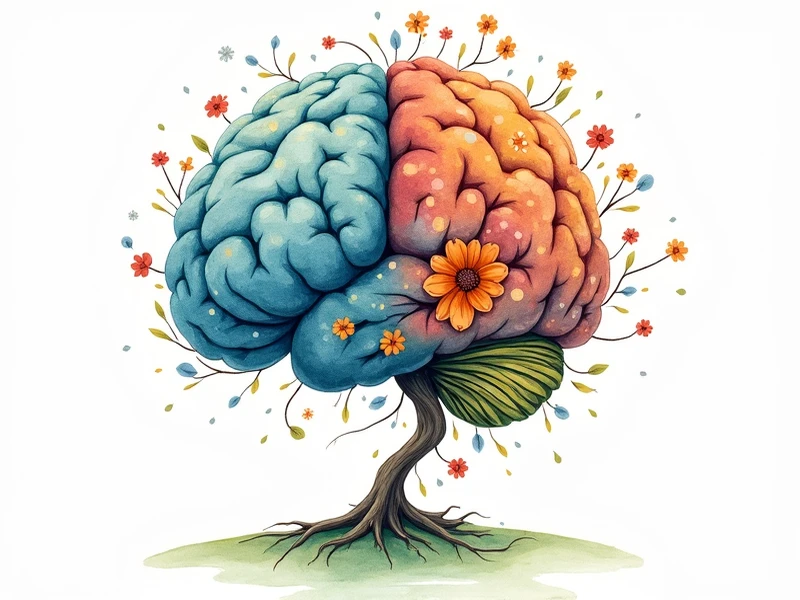Asperger Syndrome and Anxiety: A Guide to Successful Stress Management

Living with Asperger syndrome often means navigating a world that feels intensely demanding. Anxiety frequently co-occurs, creating significant challenges in daily life. Understanding this link is the first step toward effective management. This guide explores the relationship between Asperger’s and anxiety, offering practical strategies for stress reduction and burnout prevention, crucial knowledge for anyone seeking balance.
Understanding the Link Between Asperger Syndrome and Anxiety
The connection between Asperger syndrome (now often diagnosed under the umbrella of Autism Spectrum Disorder or ASD) and anxiety disorders is well-documented. Individuals on the spectrum experience anxiety at significantly higher rates than the neurotypical population. This heightened vulnerability stems from a combination of neurological differences and the stress of navigating a world not always designed with neurodiversity in mind. Recognizing these factors is key to developing empathy and effective support strategies.
- Prevalence of Anxiety in Individuals with Asperger Syndrome
Research consistently shows elevated rates of anxiety among individuals with Asperger’s. Conditions like generalized anxiety disorder, social anxiety, and specific phobias are common companions. This isn’t a personal failing but often a result of the inherent challenges associated with the neurotype, including difficulties with uncertainty and processing social cues, leading to a state of frequent apprehension. Understanding this prevalence helps contextualize the need for targeted anxiety stress management techniques.
- Sensory Sensitivities and Overstimulation as Anxiety Triggers
Many individuals with Asperger’s have heightened sensory sensitivities. Bright lights, loud noises, strong smells, or certain textures can be overwhelming, even painful. This constant potential for sensory overload can trigger the body’s stress response, leading directly to feelings of anxiety and a desire to escape the triggering environment. Managing sensory input becomes a critical component of anxiety management.
- Social Challenges and Their Impact on Anxiety Levels
Navigating complex social interactions can be a major source of stress and anxiety for those with Asperger’s. Difficulties interpreting non-verbal cues, understanding unspoken social rules, or predicting others’ reactions can make social situations feel like minefields. This social anxiety can lead to avoidance, isolation, and further exacerbate feelings of unease and worry about social performance.
Anxiety Stress Management Techniques for Asperger Syndrome
Developing effective coping mechanisms is vital. While the experience is unique to each individual, several core anxiety stress management techniques have proven beneficial for those managing Asperger’s and anxiety. The goal is to create a sense of control and predictability, reducing the triggers that lead to overwhelm and distress. Implementing these requires patience and consistency.
- Creating a Structured and Predictable Environment
Routine and predictability can be incredibly calming. Knowing what to expect reduces uncertainty, a common anxiety trigger. Establishing clear daily schedules, organizing living and work spaces logically, and preparing for changes in advance can significantly lower baseline anxiety levels. This structure provides a framework that makes the world feel safer and more manageable.
- Implementing Relaxation Techniques (Deep Breathing, Mindfulness)
Teaching the body to relax on command is a powerful tool. Techniques like deep, diaphragmatic breathing activate the parasympathetic nervous system, counteracting the fight-or-flight response associated with anxiety. Mindfulness practices encourage present-moment awareness without judgment, helping individuals detach from anxious thoughts about the past or future. Regular practice builds resilience against stress. [Internal Link: Learn More About Mindfulness Exercises]
- Developing Social Skills and Communication Strategies
 Targeted social skills training can demystify social interactions and build confidence. Learning explicit communication strategies, practicing conversations in safe environments, and understanding different social contexts can reduce the anxiety associated with social situations. Role-playing and direct instruction are often effective methods for acquiring these skills, making social engagement less daunting.
Targeted social skills training can demystify social interactions and build confidence. Learning explicit communication strategies, practicing conversations in safe environments, and understanding different social contexts can reduce the anxiety associated with social situations. Role-playing and direct instruction are often effective methods for acquiring these skills, making social engagement less daunting.
How to Manage ADHD Anxiety and Co-occurring Conditions
It’s common for individuals with Asperger’s or ADHD to experience overlapping challenges, including anxiety and sometimes depression. Effectively managing these co-occurring conditions requires a comprehensive approach that addresses the unique interplay between neurodevelopmental differences and mental health symptoms. Learning how to manage adhd anxiety often involves similar principles but may require specific focus on executive function support.
- Addressing Co-occurring Conditions: Depression and Anxiety Management
When anxiety coexists with depression or ADHD, treatment must address all facets. Depression and anxiety management might involve therapy focusing on cognitive distortions common in both, alongside strategies specifically tailored for ADHD challenges like impulsivity or focus difficulties. Recognizing how these conditions influence each other is crucial for finding effective relief and improving overall well-being.
- The Role of Medication in Managing Anxiety and ADHD Symptoms
Medication can be a helpful tool for some individuals in managing severe anxiety or core ADHD symptoms. Stimulant or non-stimulant medications may improve focus and reduce hyperactivity in ADHD, indirectly easing anxiety. Anti-anxiety or antidepressant medications might be prescribed to directly target anxiety or mood symptoms. Decisions about medication should always be made in consultation with a qualified healthcare professional after discussing potential benefits and side effects. [External Link: Reputable Mental Health Information Source, e.g., NIMH]
- Therapeutic Approaches: Cognitive Behavioral Therapy (CBT) and Exposure Therapy
Therapy offers structured ways to change thought patterns and behaviors contributing to anxiety. Cognitive Behavioral Therapy (CBT) is highly effective for anxiety, helping individuals identify and challenge negative thinking patterns and develop coping skills. Exposure Therapy, a specific CBT technique, gradually exposes individuals to feared situations or triggers in a controlled way, reducing avoidance and anxiety over time. These therapies can be adapted for the unique needs of individuals with Asperger’s or ADHD.
Recognizing Burnout: A Key Factor in Anxiety and Stress
Beyond daily anxiety management, understanding the risk of burnout is critical, especially for neurodivergent individuals who may face additional workplace stressors. Burnout isn’t just feeling tired; it’s a state of profound exhaustion resulting from chronic, unmanaged stress, often related to work but impacting all life areas. Recognizing its signs is vital for prevention and recovery.
Defining Burnout: Physical, Mental, and Emotional Exhaustion
Burnout is more than just a bad week; it’s a serious condition arising from prolonged exposure to overwhelming stress. Originally described in helping professions, it’s now recognized across all fields. The World Health Organization’s ICD-11 classifies it specifically as an occupational phenomenon, distinct from general life stress, though the lines can blur.
- ICD-11 Definition of Occupational Burnout
The ICD-11 defines burnout as “”a syndrome conceptualized as resulting from chronic workplace stress that has not been successfully managed.”” This official recognition underscores its significance as a workplace health issue. It emphasizes that burnout stems from systemic problems within the work environment, not just individual limitations. Understanding this definition helps shift focus from self-blame to identifying root causes.
- Symptoms of Burnout: Energy Depletion, Cynicism, Reduced Efficacy
Burnout manifests across three key dimensions, according to the ICD-11 and leading researchers. Firstly, overwhelming feelings of energy depletion or exhaustion. Secondly, increased mental distance from one’s job, often presenting as cynicism, negativism, or apathy towards work. Thirdly, a sense of reduced professional efficacy 閳?feeling incompetent and lacking achievement in your work. These symptoms create a downward spiral impacting performance and well-being.
- Differentiating Burnout from Typical ADHD Challenges
 It’s important to distinguish burnout from the natural energy fluctuations common with ADHD. Hyperfocusing intensely on a project followed by a need for significant recovery time is characteristic of many ADHD brains; this isn’t burnout. Burnout involves a deeper, more pervasive exhaustion coupled with cynicism and detachment from work that was previously engaging. Forcing someone with ADHD to work against their natural rhythms can, paradoxically, contribute to burnout.
It’s important to distinguish burnout from the natural energy fluctuations common with ADHD. Hyperfocusing intensely on a project followed by a need for significant recovery time is characteristic of many ADHD brains; this isn’t burnout. Burnout involves a deeper, more pervasive exhaustion coupled with cynicism and detachment from work that was previously engaging. Forcing someone with ADHD to work against their natural rhythms can, paradoxically, contribute to burnout.
The Mismatch Model: Identifying Workplace Stressors
Burnout often arises from fundamental mismatches between the individual and their work environment. Researchers have identified six key areas where these mismatches commonly occur. Recognizing these potential friction points is crucial for both employees and employers seeking to prevent burnout and foster engagement. Addressing these mismatches proactively is key.
- Six Dimensions of Mismatch: Workload, Control, Reward, Community, Fairness, Values
These dimensions pinpoint specific workplace issues: excessive workload or insufficient resources; lack of control, micromanagement, or accountability without authority; inadequate reward (pay, acknowledgment, satisfaction); poor community (isolation, conflict, disrespect); perceived unfairness (discrimination, favoritism); and value conflicts (ethical dilemmas, meaningless tasks). Significant mismatches in one or more areas, especially those important to the individual, increase burnout risk.
- How Mismatches Lead to Burnout and Anxiety
When these mismatches persist, they create chronic stress. Constantly battling an overwhelming workload, feeling powerless, unappreciated, isolated, treated unfairly, or doing meaningless work depletes mental and emotional resources. This sustained stress response, if unmanaged, directly contributes to the exhaustion, cynicism, and reduced efficacy characteristic of burnout, often intertwined with heightened anxiety.
- The Impact of Unaddressed Mismatches
Ignoring these mismatches allows chronic stress to fester, ultimately leading to burnout. The damage isn’t temporary; even after the specific stressor is removed, recovery can be lengthy. Pushing through burnout makes it worse, potentially causing long-lasting effects on mental and physical health, career trajectory, and overall quality of life. Early identification and action are vital.
Burnout and Mental Health Conditions: Asperger Syndrome and ADHD
Individuals with neurodevelopmental conditions like Asperger syndrome and ADHD may be disproportionately affected by workplace stressors and thus more vulnerable to burnout. Sensory sensitivities, challenges with executive function or social communication, and a potential need for specific accommodations can make navigating standard work environments more demanding, increasing the likelihood of mismatches.
- Disproportionate Impact on Individuals with ADHD and Asperger Syndrome
The inherent traits associated with Asperger’s and ADHD can amplify the impact of workplace mismatches. For instance, difficulties with change or ambiguity might make lack of control more stressful. Sensory sensitivities can make a standard office environment contribute to workload stress. Social communication differences might exacerbate feelings of isolation within a team. This necessitates a more mindful approach from employers.
- The Importance of Workplace Awareness and Support
Workplaces need to foster awareness and provide adequate support for neurodivergent employees. This includes understanding potential challenges, offering reasonable accommodations, and promoting an inclusive culture. Blaming the individual for struggling or encouraging them to simply “”push through”” ignores the systemic nature of burnout and can be particularly harmful for those already managing underlying conditions like Asperger’s or ADHD.
- Addressing Burnout: Collaboration and Early Intervention
Tackling burnout requires a collaborative effort between the employee and the organization. It involves identifying the specific mismatches and working together to address them. Early intervention is key; catching burnout in its early stages allows for quicker recovery. This collaborative approach benefits everyone by maintaining employee well-being and productivity. People don’t burn out due to weakness; they burn out from prolonged mismatch.
Practical Strategies for Stress Management and Burnout Prevention
Preventing burnout and managing ongoing stress and anxiety requires a combination of supportive environments and personal coping strategies. This section provides actionable advice for both organizations and individuals, offering a pathway towards better well-being. Implementing these forms the core of asperger syndrome and anxiety a guide to successful stress management.
Creating a Supportive Work Environment
Organizations play a massive role in preventing burnout. It’s not solely an individual responsibility; systemic factors must be addressed. A truly supportive environment recognizes the human element and prioritizes sustainable working practices. This involves fostering open dialogue and actively working to resolve workplace stressors.
- Open Communication and Feedback
Establishing channels for honest, bidirectional communication is fundamental. Employees should feel safe voicing concerns about workload, control, or other potential mismatches without fear of reprisal. Regularly soliciting feedback and acting upon it demonstrates that employee well-being is valued, fostering trust and enabling collaborative problem-solving around stressors.
- Addressing Systemic Issues Contributing to Burnout
Organizations must look beyond individual cases and examine systemic issues. Are workloads consistently unrealistic? Is there a culture of micromanagement? Are reward systems fair? Tackling these root causes 閳?the mismatches 閳?is essential for widespread burnout prevention. This requires commitment from leadership to change policies and practices that contribute to chronic stress.
- Promoting Work-Life Balance and Employee Well-being
Encouraging healthy boundaries between work and personal life is crucial. This includes respecting working hours, encouraging breaks and vacations, and offering resources that support mental and physical health. Flexible work arrangements, where feasible, can also significantly improve control and reduce stress for many employees, particularly neurodivergent individuals.
Personal Strategies for Managing Stress and Anxiety
While organizational support is vital, individuals also have agency in managing their stress and preventing burnout. Developing personal coping mechanisms and self-awareness provides a buffer against daily pressures and helps maintain equilibrium. These strategies are central to any effective plan for depression and anxiety management.
- Prioritizing Self-Care and Relaxation
Actively scheduling time for activities that recharge you is non-negotiable. This could include hobbies, exercise, spending time in nature, meditation, or simply resting. Recognizing your own needs and ensuring they are met helps build resilience against stress. Self-care isn’t selfish; it’s essential maintenance for your well-being.
- Setting Realistic Goals and Boundaries
Learning to say ‘no’ to excessive demands and setting achievable goals is crucial for managing workload and preventing overwhelm. Communicate your limits clearly and respectfully. Protect your personal time by establishing boundaries around work hours and availability. This helps maintain a sense of control, counteracting a key burnout trigger.
- Seeking Professional Support and Therapy
Don’t hesitate to seek help when needed. Therapists, counselors, or coaches can provide tools and strategies for managing anxiety, stress, and burnout symptoms. They offer a confidential space to explore challenges and develop coping mechanisms tailored to your specific needs, including navigating asperger syndrome and anxiety or how to manage adhd anxiety. BrainTalking often emphasizes the value of professional guidance. [Internal Link: Find a Therapist Directory/Resource]
The Role of Tools and Resources in Stress Management
Leveraging tools and resources can significantly aid in managing stress, staying organized, and achieving goals, which indirectly combats burnout factors like lack of control or reduced efficacy. From simple planners to technology platforms, finding the right aids can make a tangible difference in daily functioning.
- Utilizing Planners and Journals for Goal Setting and Focus (e.g., Hero’s Journal)
Tools designed to help structure tasks and goals can be incredibly beneficial, especially for those with ADHD or Asperger’s who may struggle with executive function. Planners like the Hero’s Journal, mentioned in the reference text, use engaging frameworks to break down large goals, track progress, and maintain focus, fostering a sense of accomplishment and control. Finding a system that works for your brain is key.
- Leveraging Technology for Organization and Productivity
Numerous apps and software exist to help manage time, tasks, and information. Digital calendars, task management apps, note-taking software, and reminder systems can help offload cognitive demands, reducing mental clutter and preventing overwhelm. Experiment to find tech tools that streamline your workflow and support your organizational needs.
- Building a Support Network and Seeking Guidance
 Connecting with others who understand your experiences can be incredibly validating and helpful. Seek out support groups (online or in-person), connect with mentors, or simply lean on trusted friends and family. Sharing challenges and successes with a supportive community reduces feelings of isolation, a known contributor to burnout and anxiety.
Connecting with others who understand your experiences can be incredibly validating and helpful. Seek out support groups (online or in-person), connect with mentors, or simply lean on trusted friends and family. Sharing challenges and successes with a supportive community reduces feelings of isolation, a known contributor to burnout and anxiety.
Key Takeaways for Managing Asperger’s, Anxiety, and Burnout:
- Anxiety is common with Asperger syndrome due to sensory, social, and processing differences.
- Structured environments, relaxation techniques, and social skills support are effective anxiety stress management techniques.
- Burnout stems from chronic workplace stress due to mismatches (workload, control, reward, community, fairness, values).
- Burnout is NOT a personal failing but often a systemic issue, disproportionately affecting neurodivergent individuals.
- Addressing burnout requires collaboration between individuals and organizations to fix mismatches.
- Personal strategies (self-care, boundaries, professional help) and supportive tools are crucial for prevention and management.
- Understanding these dynamics is vital for anyone creating their own asperger syndrome and anxiety a guide to successful stress management.
Q&A: Understanding Your Anxiety
Question: How can I tell if my anxiety is primarily related to my Asperger’s/ADHD or if it’s a sign of burnout?
Answer: This is an excellent question, as the symptoms can overlap significantly, causing confusion. Differentiating involves looking at the context and characteristics of your anxiety and exhaustion.
Anxiety intrinsically linked to Asperger’s or ADHD often relates directly to core traits. For example:
- Social Anxiety: Intense fear or discomfort specifically in social situations due to difficulties interpreting cues or fear of judgment.
- Sensory Overload Anxiety: Feeling overwhelmed and anxious triggered by specific sensory stimuli (lights, sounds, crowds).
- Anxiety from Uncertainty/Change: Significant distress when routines are disrupted or outcomes are unknown.
- ADHD-related Anxiety: Feeling anxious due to difficulties with time management, organization, meeting deadlines, or impulsivity leading to negative consequences.
Burnout, while also causing anxiety, typically develops over time due to chronic workplace stress and specific mismatches. Key indicators lean towards:
- Pervasive Exhaustion: Deep physical and emotional depletion that rest doesn’t easily fix.
- Cynicism/Detachment: Feeling increasingly negative, critical, or disconnected from your work, colleagues, or the purpose of your job 閳?even work you used to enjoy.
- Reduced Efficacy: A persistent feeling of incompetence or lack of achievement in your work, regardless of actual performance.
- Work-Specific Trigger: While burnout affects overall life, the root cause and most intense feelings are often tied directly to job stressors and mismatches (workload, lack of control, etc.).
Think about: Did your intense anxiety and exhaustion onset gradually after a prolonged period of high stress specifically at work? Do you feel cynical and detached from your job specifically? Or is your anxiety more consistently tied to specific social, sensory, or executive function challenges that have been present longer-term? Often, it can be a combination, where underlying vulnerabilities are exacerbated by workplace stress leading to burnout. Consulting with a mental health professional familiar with both neurodiversity and burnout can provide clarity and tailored strategies. Here at BrainTalking, we believe understanding these nuances is key to effective support.




